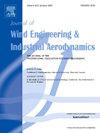Vortex-induced vibration mitigation in long-span bridges using a nonlinear energy sink inerter: Theoretical framework and application
IF 4.9
2区 工程技术
Q1 ENGINEERING, CIVIL
Journal of Wind Engineering and Industrial Aerodynamics
Pub Date : 2025-07-31
DOI:10.1016/j.jweia.2025.106193
引用次数: 0
Abstract
Long-span bridges, with their exceptionally low modal frequencies, are prone to wind-induced vibrations, notably vortex-induced vibrations (VIVs). Conventional linear dynamic vibration absorbers like tuned mass dampers (TMDs), and nonlinear dynamic absorbers such as nonlinear energy sinks (NESs), often struggle to mitigate VIV effectively at low frequencies due to excessive static displacements and limited achievable mass ratios. To overcome these challenges, this study proposed a novel vibration control device—a quasi-zero-stiffness nonlinear energy sink inerter (QZS-NESI). By introducing a positive linear stiffness component, the QZS-NESI achieves a quasi-zero stiffness configuration that compensates for static loads while maintaining low restoring forces. Meanwhile, the inclusion of the inerter provides a mass amplification effect, effectively reducing the static displacement requirement. The complexification-averaging (CX-A) technique was used to obtain the slow-flow dynamic model and steady-state dynamic model of the original system, which approximated by the CX-A method has been demonstrated to possess accuracy comparable to that of the original system. Moreover, this method enabled the direct determination of the steady-state amplitude and phase difference of the dynamic system, thereby elucidating the bifurcation structure of the system under varying parameters. The mechanical damping and VIV-related aerodynamic damping were identified as critical parameters significantly influencing the emergence of unstable branches. The Xihoumen Bridge, with a main span of 1650 m, was chosen as the reference bridge to evaluate the VIV control efficacy of the NESI system. Findings underscored the exceptional capacity of NESI for displacement reduction and broadband vibration mitigation.
基于非线性能量汇的大跨度桥梁涡激振动抑制:理论框架与应用
大跨度桥梁由于其模态频率极低,容易产生风致振动,尤其是涡致振动。传统的线性动态吸振器(如调谐质量阻尼器(TMDs))和非线性动态吸振器(如非线性能量汇(NESs)),由于静态位移过大和可实现的质量比有限,通常难以在低频有效地减轻VIV。为了克服这些挑战,本研究提出了一种新型的振动控制装置——准零刚度非线性能量吸收器(QZS-NESI)。通过引入正线性刚度分量,QZS-NESI实现了准零刚度配置,在保持低恢复力的同时补偿静态负载。同时,该干涉器的加入提供了质量放大效应,有效降低了静位移要求。采用复化平均(CX-A)技术得到了原系统的慢流动力学模型和稳态动力学模型,经验证,CX-A方法近似得到的模型精度与原系统相当。此外,该方法可以直接确定动态系统的稳态幅值和相位差,从而阐明系统在变参数下的分岔结构。机械阻尼和涡激气动阻尼是影响不稳定分支产生的关键参数。选取主跨1650 m的西堠门大桥作为参考桥梁,评价NESI系统的VIV控制效果。研究结果强调了NESI在减少位移和减缓宽带振动方面的卓越能力。
本文章由计算机程序翻译,如有差异,请以英文原文为准。
求助全文
约1分钟内获得全文
求助全文
来源期刊
CiteScore
8.90
自引率
22.90%
发文量
306
审稿时长
4.4 months
期刊介绍:
The objective of the journal is to provide a means for the publication and interchange of information, on an international basis, on all those aspects of wind engineering that are included in the activities of the International Association for Wind Engineering http://www.iawe.org/. These are: social and economic impact of wind effects; wind characteristics and structure, local wind environments, wind loads and structural response, diffusion, pollutant dispersion and matter transport, wind effects on building heat loss and ventilation, wind effects on transport systems, aerodynamic aspects of wind energy generation, and codification of wind effects.
Papers on these subjects describing full-scale measurements, wind-tunnel simulation studies, computational or theoretical methods are published, as well as papers dealing with the development of techniques and apparatus for wind engineering experiments.

 求助内容:
求助内容: 应助结果提醒方式:
应助结果提醒方式:


